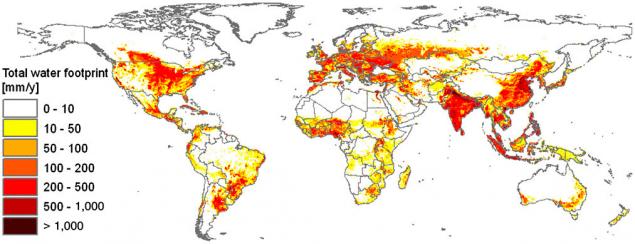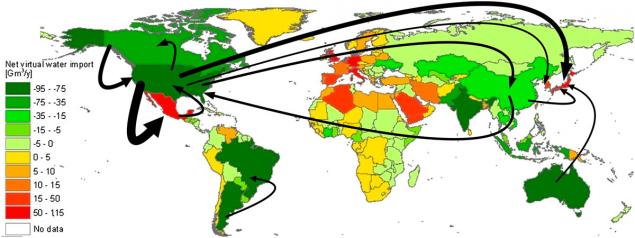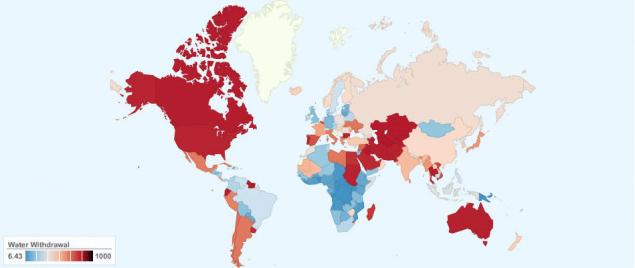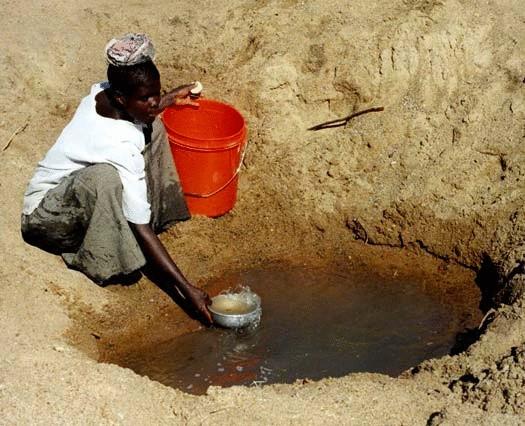Where the water goes?
 Bashny.Net
Bashny.Net
The study, published in the proceedings of the National Academy of Sciences, the third attempt by scientists to deal with the painful problem of global water. The researchers analyzed the different ways of consumption of water by mankind: the volume of rainwater utilization, the volume of depletion of underground and surface sources and volume of water contamination.

If you take into account the global scale, 92% of fresh water is spent on agriculture. Moreover, the production of food grains (wheat, rice, corn, etc.) the hygroscopic and it takes 27% of global water footprint. According to the study, meat production consumes 22% and milky - 7%.

The US ranks third in the consumption of fresh water, second only to the more populated China and India, although their territory falls only 5% of the world population. Water consumption per capita in the U.S. is 2,842 cubic meters a year, or 100,364 cubic feet, in comparison with 1,089 cubic meters for China and 1,071 in India.

Water consumption per capita in the UK is 1,258 cubic meters per year. The difference may not be evident, right? Who would have thought that blame the usual beef that Americans consume 4.5 times more than the world average, whereas the Brits eat it twice more than is the norm elsewhere. And, in fact, rarely think about the fact how much water is spent on grain feeding of cattle.

This study valuable and the fact that scientists have studied the flow of “virtual water” between countries. This term is used when, for example, rice grown in Asia using Asian water, are exported to Africa. According to the study, about 1/5 of the total volume of water consumed in the world in the form of virtual. Tracking such flows allows to identify those countries that depend on foreign supply and to what extent they contribute to pollution and reduction of water over their territories.

The largest net exporters of virtual water in North and South America, South Asia and Australia, while net importers North Africa, Middle Asia, Mexico, Europe, Japan and South Korea.
The study also showed that the exported goods are polluting and consume more surface water than those that it offers the domestic market. The least sustainable patterns of water use per capita prevalent in the countries of Central and South-West Asia and North Africa. This fact is due to the limited supply of groundwater.

Scientists hope that the study will help governments to evaluate the different factors influencing the water footprint of States, and to correct unsustainable consumption and inefficiency in production. For example, Bolivia consumes meat only 1.3 more than average planet, but it has a huge impact on its water footprint, since each consumed a ton of meat in Bolivia requires water for its production five times more than the world average.
Source: /users/1

If you take into account the global scale, 92% of fresh water is spent on agriculture. Moreover, the production of food grains (wheat, rice, corn, etc.) the hygroscopic and it takes 27% of global water footprint. According to the study, meat production consumes 22% and milky - 7%.

The US ranks third in the consumption of fresh water, second only to the more populated China and India, although their territory falls only 5% of the world population. Water consumption per capita in the U.S. is 2,842 cubic meters a year, or 100,364 cubic feet, in comparison with 1,089 cubic meters for China and 1,071 in India.

Water consumption per capita in the UK is 1,258 cubic meters per year. The difference may not be evident, right? Who would have thought that blame the usual beef that Americans consume 4.5 times more than the world average, whereas the Brits eat it twice more than is the norm elsewhere. And, in fact, rarely think about the fact how much water is spent on grain feeding of cattle.

This study valuable and the fact that scientists have studied the flow of “virtual water” between countries. This term is used when, for example, rice grown in Asia using Asian water, are exported to Africa. According to the study, about 1/5 of the total volume of water consumed in the world in the form of virtual. Tracking such flows allows to identify those countries that depend on foreign supply and to what extent they contribute to pollution and reduction of water over their territories.

The largest net exporters of virtual water in North and South America, South Asia and Australia, while net importers North Africa, Middle Asia, Mexico, Europe, Japan and South Korea.
The study also showed that the exported goods are polluting and consume more surface water than those that it offers the domestic market. The least sustainable patterns of water use per capita prevalent in the countries of Central and South-West Asia and North Africa. This fact is due to the limited supply of groundwater.

Scientists hope that the study will help governments to evaluate the different factors influencing the water footprint of States, and to correct unsustainable consumption and inefficiency in production. For example, Bolivia consumes meat only 1.3 more than average planet, but it has a huge impact on its water footprint, since each consumed a ton of meat in Bolivia requires water for its production five times more than the world average.
Source: /users/1
Tags
s.o.s
potreblenie world of water
world of water stocks
flows
virtual water
groundwater
water consumption per capita
where does drinking water
See also
"Confusion-on-a-chip": another step towards quantum computers
10 interesting facts about every food
16 benefits of daily sex. Life without stress? It sounds tempting!
The geometry of four-dimensional time: it is not how the world works how we think
Error survivors
The consequences can be very serious: how digital technologies affect our body and brain
Lee Kuan yew: As whipping sticks to turn his country into one of the leading powers of the world
What is sustainable development in the modern world
Endocrinologist Robert Lustig: Allowed worldwide drug

















